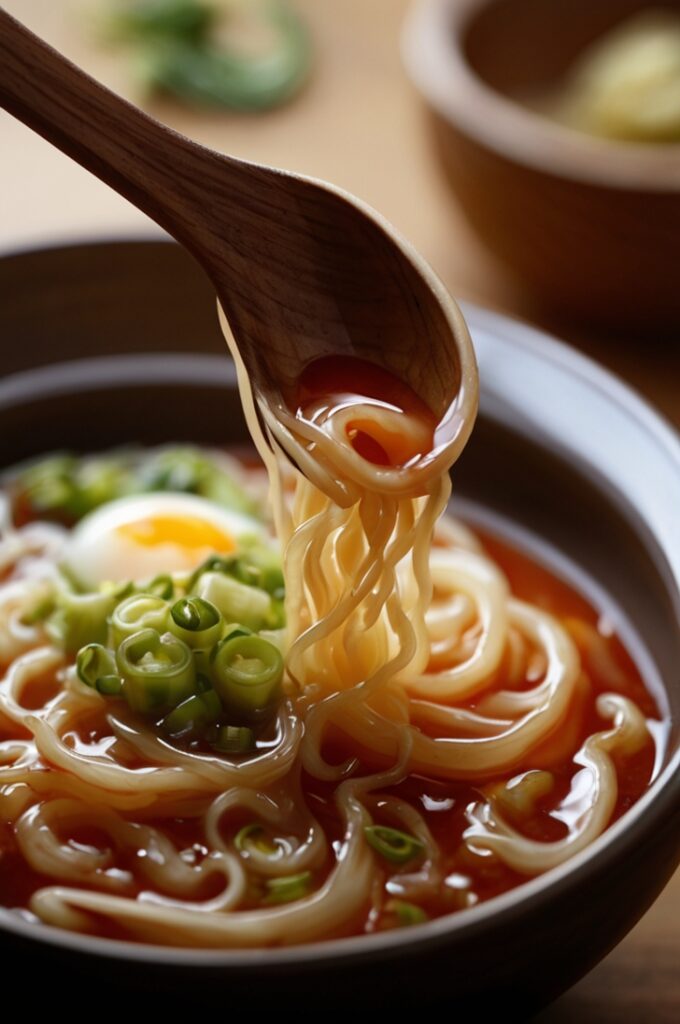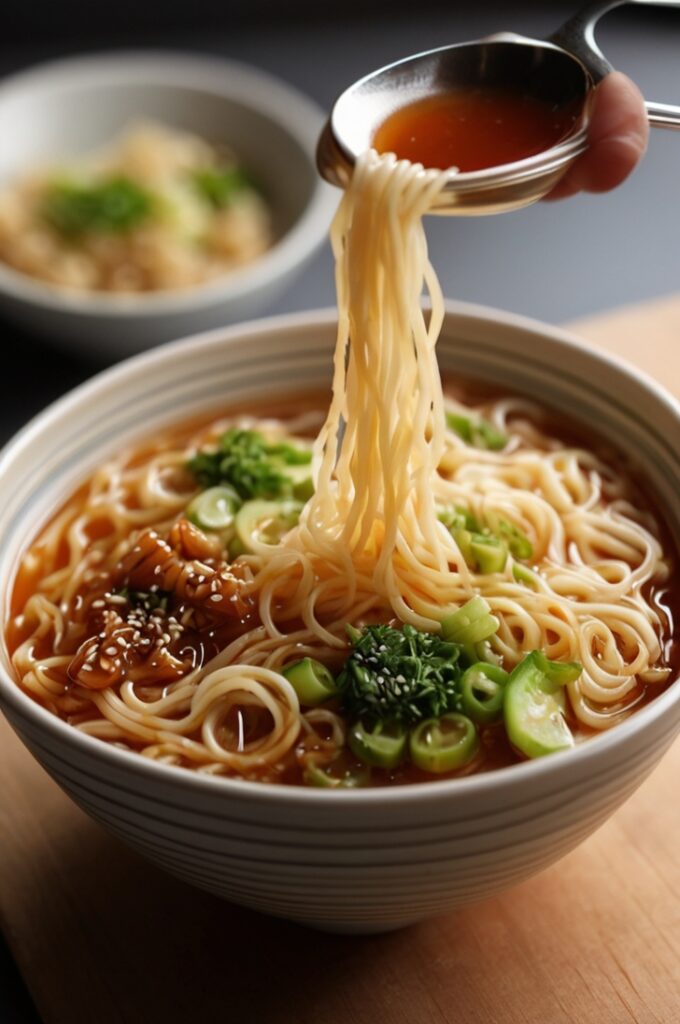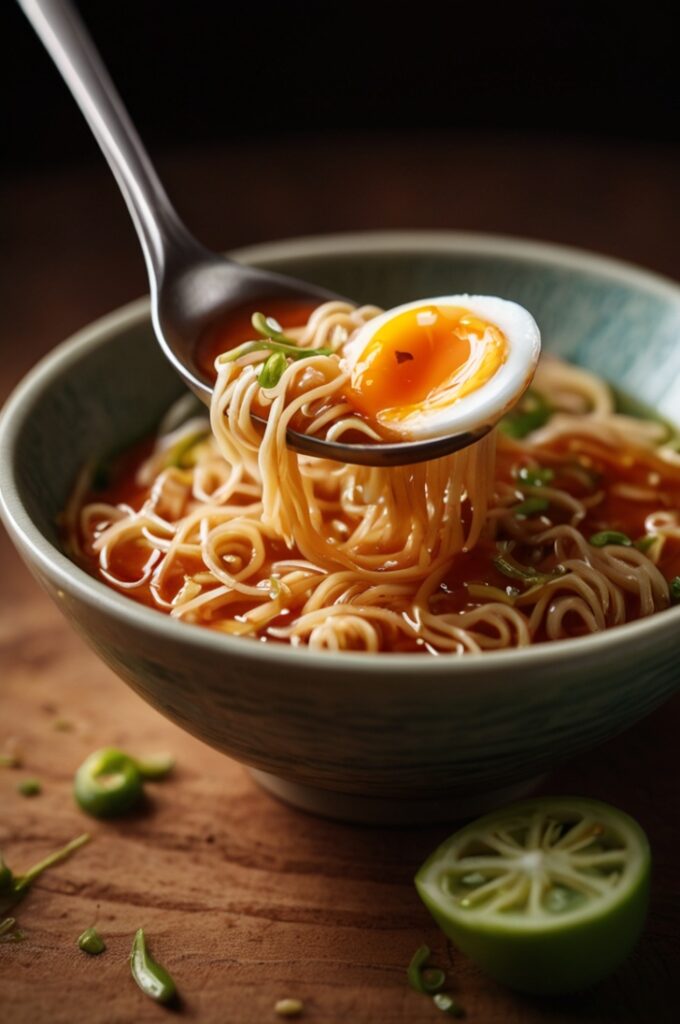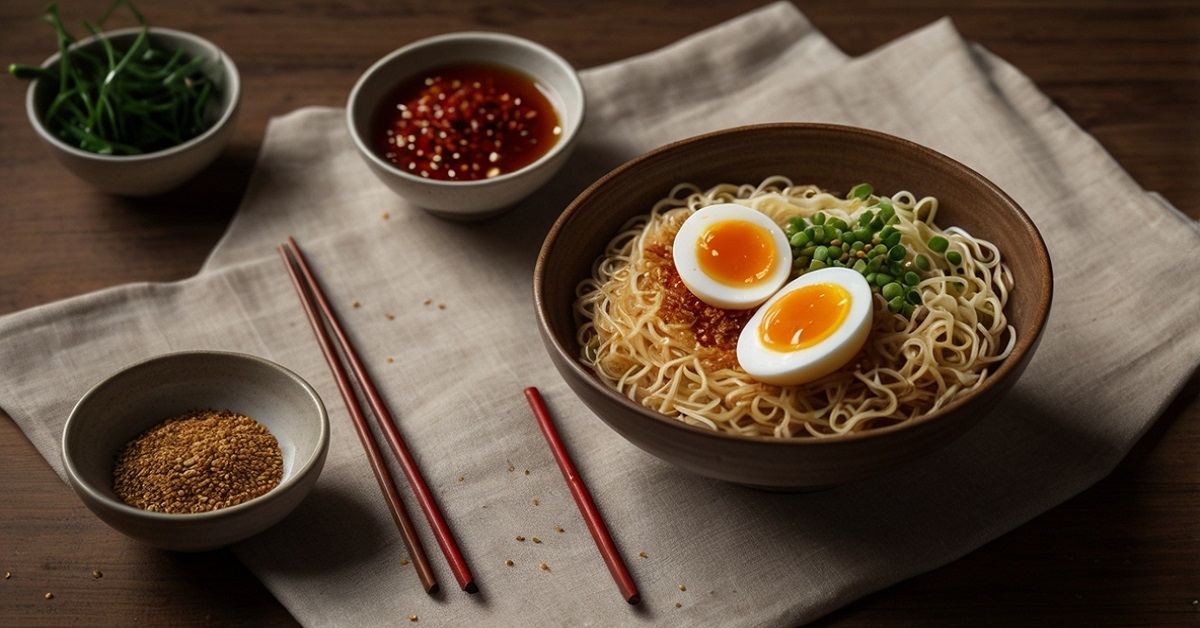Sweet and Spicy Ramen Noodles aren’t just dinner they’re a damn experience. I still remember slurping a fiery bowl of ramen at 2 a.m. in a cramped alleyway noodle bar somewhere in Osaka, steam fogging up my glasses, tears welling not from sadness but from sheer chili euphoria. A little drunk, maybe. Very alive, definitely. That bowl ruined plain ramen for me forever. I’ve been chasing that high ever since.
This Sweet and Spicy Ramen Noodles recipe? It’s a proper contender. Loud, bold, sweet where it needs to be, spicy where it counts. Sticky sauce that clings to noodles like gossip. No broth here this one’s a stir-fried, punch-you-in-the-face flavor bomb. One of those dishes where you finish, blink, and wonder why your bowl is suddenly empty.
And the best part? Takes under 30 minutes. Yeah, we’re talking pantry-to-plate in less time than it takes to watch a rerun of Chopped.
What Makes This Ramen Recipe Special?

Forget the sad college noodles floating in mystery broth. This is ramen leveled up with a sticky glaze of gochujang, soy, garlic, and brown sugar. It’s not soupy it’s saucy. Think Korean-style stir-fry meets Japanese comfort food.
A bit of heat, a touch of sweetness, and a deep savory thump thanks to sesame oil and aromatics.
We’re playing with textures here too. Chewy noodles. Crisp veggies. Crunchy toppings. Everything in one forkful err, chopstickful.
Let’s dive in.
Ingredients & Substitutions
Main Ingredients:
- 2 packs ramen noodles (instant is fine ditch the flavor packet)
- 1 tablespoon neutral oil (canola, grapeseed, etc.)
- 4 garlic cloves, smashed and minced
- 1 thumb-sized piece of fresh ginger, grated
- 2 tablespoons soy sauce (light or all-purpose)
- 1 tablespoon gochujang (Korean chili paste see sub)
- 1½ tablespoons brown sugar
- 1 teaspoon rice vinegar
- 1 tablespoon sesame oil
- ¼ cup water or noodle cooking water
- 1 small carrot, julienned
- ½ cup thinly sliced bell pepper
- 2 green onions, sliced
- Toasted sesame seeds, for garnish
- Fried egg, for topping (optional but wow)
- Chili flakes or chili crisp, to taste
Substitutions & Insights:
Can’t find gochujang? Try sambal oelek or Sriracha, though the depth won’t quite match. Add a little miso paste to mimic the funk.
Brown sugar adds body and molasses warmth, but honey or maple syrup work too just a touch less sweet.
Rice vinegar cuts the sugar’s cling; don’t skip. Apple cider vinegar is a fair stand-in, just use a bit less.
For veggies, sky’s the limit. Broccoli, snow peas, shredded cabbage whatever crunch you’ve got.
And those noodles? Fresh ramen is dreamy, but let’s be real instant does the job. Just don’t overcook ’em. Chewy is key.
Step-by-Step Instructions (Expert-Level But Friendly)

1. Cook Your Noodles (but don’t walk away)
Boil ramen noodles according to the package usually 2–3 minutes max. Pull them early. We want chewy, not mush.
Reserve ¼ cup of that starchy cooking water. Drain the rest. Toss noodles with a drizzle of sesame oil so they don’t clump like a sad ball of yarn.
2. Build That Flavor Base
Heat neutral oil in a large skillet or wok over medium heat. Toss in your garlic and ginger. Stir constantly burnt garlic ruins dreams.
You’ll smell it go from sharp to warm. That’s your cue.
3. Add Sauce Ingredients Straight to the Pan
Drop in soy sauce, gochujang, brown sugar, rice vinegar, and sesame oil. Stir to combine.
Let it bubble for 1–2 minutes. Add the noodle water to thin it slightly and help it coat everything like magic.
4. Veggies Time
Toss in your carrots and peppers. Stir-fry for about 1–2 minutes. You want ’em tender-crisp not floppy.
This isn’t a soup veggies gotta stand up to the sauce.
5. Add the Noodles and Coat Like You Mean It
Toss in your drained noodles. Use tongs to really get in there coat every strand like it owes you money.
Cook another 1–2 minutes ‘til it all comes together and the sauce clings like velvet.
6. Taste, Adjust, Top, Serve
Taste. Need more salt? Splash more soy. Want it hotter? Chili crisp, baby.
Top with green onions, sesame seeds, maybe a fried egg. That yolk’s gonna run into the sauce and ruin you (in a good way).
Cooking Techniques & Science (Why This Works So Damn Well)
This is a sauce-driven stir-fry. High heat. Fast movement. You’re not simmering or slow cooking you’re building layers, quickly.
Why garlic first? Because flavor blooms in oil. Garlic and ginger release sulfur compounds and flavor oils into the base.
Why noodles last? So they don’t overcook or get gummy. You want that spring, that bounce.
Gochujang isn’t just spice it’s fermented. That fermentation gives depth, like soy sauce but thicker. It sticks to your tongue and makes you crave another bite.
Sesame oil’s not for cooking it burns fast. It’s a finisher, a perfume. Add it toward the end for that toasty, nutty inhale-before-you-eat moment.
And that starchy water you saved? It’s basically noodle glue. It helps the sauce hold onto the noodles instead of sliding off like disappointment.
Serving & Pairing Suggestions

Serve this hot, obviously. Room temp doesn’t do it justice it gets sticky. Like cold pizza, but sadder.
Plate it in a shallow bowl, scatter sesame seeds like confetti, and don’t be shy with that fried egg.
Top with fresh cucumber slices if you want contrast crisp + cool vs. hot + sticky = balance.
Pair with something light. Cold beer, iced jasmine tea, maybe a chilled cucumber salad with rice vinegar and sesame.
Or go full bold and serve with Korean fried chicken and pickled radish. No one’s stopping you.
FAQs: Sweet and Spicy Ramen Noodles Recipe
1. Can I make this vegetarian or vegan?
Absolutely. Just skip the egg or use a vegan alternative. Make sure your gochujang doesn’t contain anchovy (some do). Tofu or tempeh works great as protein.
2. What’s the best type of ramen noodle to use?
Fresh ramen is top-tier, but instant bricks without the seasoning packet are totally fine. Look for brands that say “chewy” or “air-dried.” Avoid overly soft noodles they’ll turn to mush fast.
3. Can I prep the sauce ahead of time?
Yep. Mix the sauce base (soy, sugar, gochujang, vinegar, sesame oil) in a jar and keep it in the fridge up to 5 days. Just stir before using.
4. What protein can I add to this?
Thinly sliced beef, ground pork, crispy tofu, soft-boiled egg, shredded rotisserie chicken pretty much anything that loves bold flavors and cooks quickly.
5. How spicy is it? Can I tone it down?
It’s medium spicy as-is. Cut the gochujang to 1 teaspoon for mild, or swap it for ketchup + a dash of chili oil. Spice is adjustable, not a rule.
Now go make it.
Slurp it loud. Eat it hot. And maybe keep a glass of milk nearby… just in case the spice sneaks up on ya.
Final Thoughts Sweet and Spicy Ramen Noodles
This Sweet and Spicy Ramen Noodles recipe walks that delicious tightrope between indulgent and fiery. You get salt, sweet, spice, and chew all in 20 minutes.
It’s a great base too. Toss in tofu, shrimp, shredded chicken, or ground pork. It adapts.
If you’re feeding a crew, double the sauce. Don’t skimp. Sauce is life.
Troubleshooting? If it tastes flat add acid. If it’s too thick more water. Too sweet? More vinegar or chili. Too salty? Add sugar or water and throw in more veg.
And the biggest sin? Overcooked noodles. Don’t do it. Set a timer if you must.




